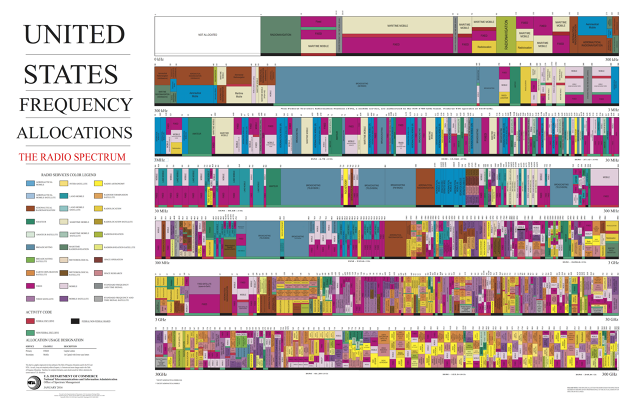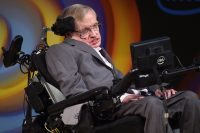The U.S. Military Offers $2 Million For Wireless Devices That Can Share The Airwaves
Wi-Fi is usually fine at home, but can be a nightmare to use at a packed convention, café, or park. A big enough crowd can kill cell reception too. It’s common to hear people say something along the lines of, “The Wi-Fi sucks here.”
In truth, Wi-Fi sucks everywhere there is a crowd not because there are too many radio waves in the air, but because wireless devices aren’t making good use of them, according to Paul Tilghman, a program manager at the U.S. military’s Defense Advanced Research Projects Agency (DARPA).
DARPA, which helped build the wired Internet, now aims to fix the wireless net with its Spectrum Collaboration Challenge, nicknamed SC2. Kicking off in 2017, it’s a competition for up to 30 teams of engineers to develop wireless devices that work together to better share the airwaves. Using artificial intelligence will be key to the process, and the team that nails it will win $2 million. The second-place team takes home $1 million, and third place brings in $750,000. This is the latest in the agency’s Grand Challenges, a series of contests for developing technologies with military and civilian benefits that have yielded robots, self-driving cars, and automated network security systems.
A new way to divvy up wireless spectrum is due, given how congested things are getting, says Tilghman, who oversees the challenge. “When you project out to the 2030 time frame, if current trends hold, you’re looking at 250 times more demand from the spectrum than what we are doing today,” he says.
Why is the U.S. military getting involved? In addition to Skype calls, Netflix streams, Pokémon Go expeditions, and every other online activity consumers are engaging in, the military has an increasingly high demand for data. This includes expanded use of “unmanned systems,” such as drones. While robots have some autonomy, they maintain close radio ties with operators. Soldiers themselves will be in closer radio contact, too. “We increasingly look at the soldier as an opportunity to collect [data] and be a sensor for us,” says Tilghman. Carrying wireless devices, troops send information such as location position and video back to planners, while also receiving instructions from base.
Good Fences Make Bad Neighbors
There’s a fixed amount of radio wave real estate for gadgets to use, and most of it’s spoken for. Wireless carriers and TV broadcasters have spent billions of dollars to lease specific frequency bands, and the military reserves its own chunks. These properties are fenced off with big No Trespassing signs. No matter how busy or empty AT&T’s chunk is at any given time, T-Mobile can’t cut across.
As Tilghman explains, that exclusivity leads to waste, with licensed spectrum even in urban areas sometimes registering only 20% usage. The idle time slots are small, but important. “If you could directly talk to the other users of the spectrum and realize that there’s going to be 10 milliseconds coming up where no one’s planning to use the spectrum, well, that’s a large opportunity,” he says. If all that empty bandwidth were shared, the same spectrum could carry from 100 to 1,000 times as much traffic as it does today, he says.

Some portions of the wireless spectrum are not covered by licenses and available for sharing, but it’s a messy process. Wi-Fi uses unlicensed spectrum in the 2.4GHz and 5.0GHz bands. Instead of property owners standing behind fences, Wi-Fi is like overly polite drivers converging at an intersection, timidly waiting for the other one to go. “[Wi-Fi] says, look it’s busy right now, I’m going to roll the dice and wait for a random amount of time, and I’m going to close my ears,” says Tilghman. “And after that I’m going to look again and say, ‘Oh is it free?'” The time spent waiting to transmit isn’t a problem with a half dozen devices at home but is a nightmare with 50, 100, or 1,000 gadgets. “It becomes exponentially inefficient,” he says.
Wi-Fi doesn’t have to suck, because the type of traffic is pretty easy to identify and downtime is easy to predict. Video streaming, for instance, will fetch and buffer a certain number of frames at a time. Getting devices like routers, phones, Fitbits, smart TVs, and others to communicate and signal to each other what their bandwidth needs are doesn’t have to be so hard, since they are all connected to the Internet. The net isn’t fast enough for devices to allocate time slots down to the millisecond, but it could allow them to compare notes about what type of traffic they are handling and predict gaps where devices can jump in.
Geek Gladiators
DARPA has just issued a formal call for teams to join SC2, publishing the full, detailed rules. DARPA is also building a battle venue, auspiciously named the Colosseum, that it says will be the largest wireless testing facility of its kind, with room to study the interactions among up to 256 different radio devices.
The agency won’t yet divulge the venue’s location or dimensions, but it will have to be quite big, based on Tilghman’s description. “Colosseum’s job is to emulate the physical world, in real-time,” he writes in an email follow-up to our call. “One minute they could be in an open field, the next they could be in a crowded city. From the radio’s perspective, these are vastly different.”
Rome was not built in a day, and this contest will take time. After three roughly yearlong phases, DARPA hopes to crown a champ after a final round in late 2019. That team will win, not by crushing its opponents, but by cooperating best with gadgets from the other teams. “We want to see what all the possible avenues are and which ones work best,” says Tilghman. “Opening that up to a big competition is really an excellent way to do that.”
DARPA’s timing is fortuitous. The Federal Communications Commission just announced plans to open huge swaths of bandwidth for new 5G cellular service, promising wireless speeds as high as 10Gbps. Much of this spectrum will be unlicensed: up for grabs by devices that will have to tightly coordinate access (lest they suffer the fate of Wi-Fi). Companies like Verizon and Ericsson are starting 5G trials soon, with standards expected to be set by the end of 2020—not long after SC2 ends.
Artificial intelligence will certainly play a role in the challenge because there are so many variables to track. Teams might use machine learning to sort through all the wireless traffic that happens in real life, uncovering patterns that may define rules and strategies for sharing the airwaves. AI will also drive the split-millisecond decisions that wireless systems must take to coordinate. That intelligence may be in each device, or it may happen in a cloud service to which they all connect.
“The chief role of AI is to figure out, given my current circumstances, given all the other radios that want to use the spectrum, given the fact that I’m in a city, whether my network is indoors rather than outdoors, given the kinds of applications running across all these wireless networks—let me custom tailor and figure out the best waveform I should use,” Tilghman says.
What AI likely can’t figure out are all the regulatory and financial implications of spectrum sharing, such as how to transition from the current leased-frequency regime. Would companies that paid fortunes for exclusive licenses get a rebate from the federal government now that the bandwidth is shared? Would they sublet access to other companies? At what point would spectrum sharing technology be considered reliable enough to trust with things like sensitive military communications? That won’t be for DARPA to figure out. “At the end of the day, DARPA’s job isn’t really to make policy here,” says Tilghman. Between now and 2020, the goal is just to see if these technologies are feasible.
Fast Company , Read Full Story
(23)













